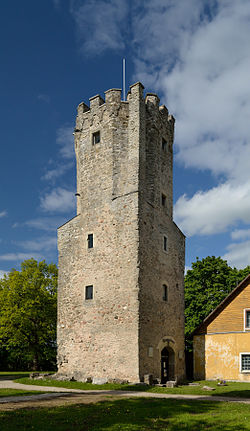Porkuni
Porkuni | |
|---|---|
Village | |
 Porkuni castle gatetower | |
 | |
| Country | |
| County | Lääne-Viru County |
| Parish | Tamsalu Parish |
| Time zone | UTC+2 (EET) |
| • Summer (DST) | UTC+3 (EEST) |
Porkuni is a village in Tamsalu Parish, Lääne-Viru County, in northern Estonia. The settlement is located around the Lake Porkuni, which is the source of the Valgejõgi River.
In 1944, the Battle of Porkuni was fought in the area.
Porkuni castle

In 1479, a castle was built on an island in the lake by the bishop of Tallinn Simon von der Borch. Porkuni castle (German: Borkholm) was a four-sided structure surrounding a central courtyard, where a small church stood. In each corner of the castle stood a cannon-tower, and there was also a gate tower which is still preserved, albeit with a few later alterations. Judging from the remains, the castle was built in different stages and the walls were gradually made higher.[1]
The castle was destroyed during the Livonian War.
In 1870-74, a new manor house was built at the site by the landowner at the time, Otto Ludwig von Rennenkampff. Perhaps not surprisingly, it is built in a neo-Gothic style, with turrets and other details inspired by a romantic perception of the Middle Ages. The ceremonial rooms of the manor, on the first floor, have been restored. The interior also houses a wrought iron staircase and a noteworthy art nouveau tiled stove.[2][3]
See also
- Lake Porkuni
- Battle of Porkuni (1944)
- List of palaces and manor houses in Estonia
- List of castles in Estonia
References
- ^ Viirand, Tiiu (2004). Estonia. Cultural Tourism. Kunst Publishers. pp. 131–132. ISBN 9949-407-18-4.
- ^ Sakk, Ivar (2004). Estonian Manors - A Travelogue. Tallinn: Sakk & Sakk OÜ. p. 158. ISBN 9949-10-117-4.
- ^ Hein, Ants (2009). Eesti Mõisad - Herrenhäuser in Estland - Estonian Manor Houses. Tallinn: Tänapäev. p. 139. ISBN 978-9985-62-765-5.
- Krahe, Friedrich-Wilhelm (2000). Burgen des deutschen Mittelalters. Grundriss-Lexikon (in German). Flechsig. p. 694. ISBN 3-88189-360-1.
External links
- Porkuni castle at Estonian Manors Portal

